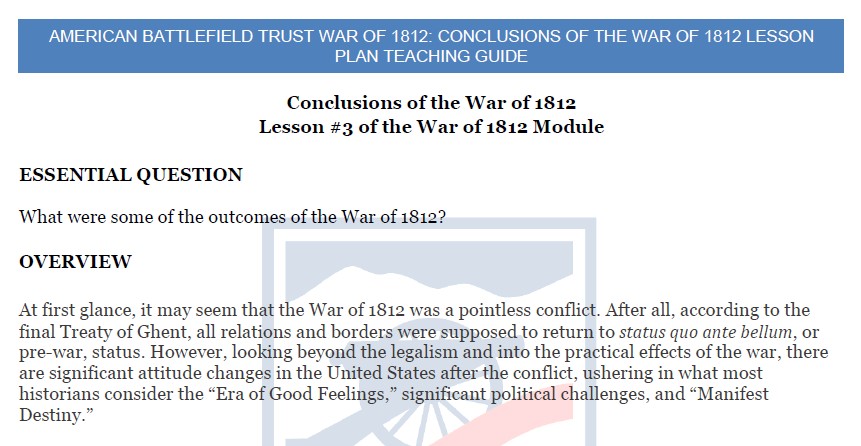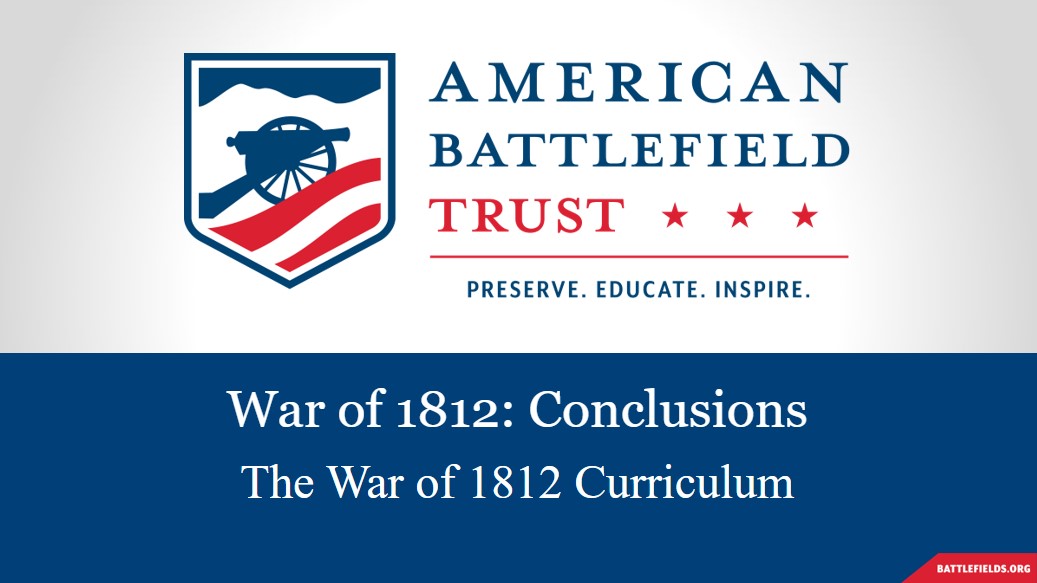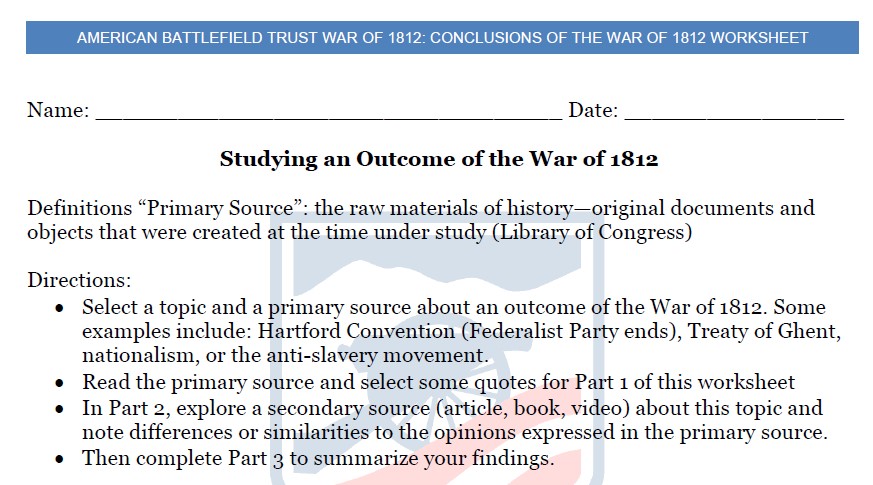
A photograph taken in 1873 by George Henry Preble of the flag that flew over Fort McHenry on the morning of September 14, 1814.
Conclusions of the War of 1812 Lesson Plan
A lesson plan for use in middle and high school classrooms.
At first glance, it may seem that the War of 1812 was a pointless conflict. After all, according to the final Treaty of Ghent, all relations and borders were supposed to return to status quo ante bellum, or pre-war, status. However, looking beyond the legalism and into the practical effects of the war, there are significant attitude changes in the United States after the conflict, ushering in what most historians consider the “Era of Good Feelings,” significant political challenges, and “Manifest Destiny.”
This Lesson Plan can be used as a prepared resource by following this curriculum plan which aligns to NCSS and Common Core Standards.
This Lesson Plan's assets can also be used on their own as supplemental resources. The display format is prepared for easy access, exploring, and learning.
Overview of the War of 1812 Module
Upon completion of this lesson, the students will be able to:
1. Knowledge
- Name and explain the outcomes of the United States’ victory in the War of 1812.
2. Comprehension/Application/Analysis
- Examine a primary and secondary source about an outcome of the War of 1812.
3. Evaluation
- Evaluate and discuss the results of the war’s outcomes and if they were beneficial.
Check out the Lesson Plan Teaching Guide for more instructions on using the prepared Lesson Plan.
Lesson Plan Primary Source Activity:
- Use the Lesson’s PowerPoint to explore the context and history; the PowerPoint introduces Essential Questions and lays foundational knowledge about the outcomes and conclusions of the War of 1812.
- Distribute the lesson’s worksheet.
- Let students decide which outcome to study: Hartford Convention (end of the Federalist Party), Treaty of Ghent, nationalism or anti-slavery movement. (There are other outcomes but there are primary and secondary sources provided for these topics on the Lesson Plan page.
- Students will read a primary source and select quotes from it; then they will read a secondary source about the same topic and a write summary of their findings.
- Encourage a class discussion about the student’s findings. Were these outcomes good? Were there drawbacks or were they harmful?
OPTIONAL HOMEWORK/ASSESSMENT/ADDITIONAL ACTIVITIES:
Option 1: Star-Spangled Banner Vocabulary
Individually, in groups, or as a classroom read The Star-Spangled Banner, and have the students make a list of words they don’t know or they question the use of the word in the poem. As a group, discuss the words and find 19th century definitions. Discuss if certain words have taken on new meanings or if they were perhaps a unique choice even in 1814. One of the popular songs from the War of 1812, are there national and patriotic themes that would have resonated with Americans after their war victory?
Option 2: Monroe Doctrine
As a class, read the Monroe Doctrine, one of the nationalism and foreign policy outcomes triggered by the War of 1812. Show the students the Western Hemisphere and geographically what it means. Consider and discuss the following questions:
- What are the main points outlined in President James Monroe's message to Congress regarding the Monroe Doctrine?
- What was the primary purpose of the Monroe Doctrine, and whom was it intended to address?
- How did the Monroe Doctrine reflect the United States’ foreign policy goals at the time?
- In what ways did the Doctrine assert U.S. influence in the Western Hemisphere?
- What impact did the Doctrine have on U.S. relations with Latin American countries?
- Can you identify any specific instances where the Monroe Doctrine was invoked or referenced in later U.S. history?
- Has the interpretation of the Monroe Doctrine changed over time?
- How do modern international relations and the concept of American influence compared to the principles set out in the Monroe Doctrine?
Common Core State Standards- ELA & History/Social Studies
Grades 6-8
- Key Ideas and Details:
- CCSS.ELA-LITERACY.RH.6-8.1
- Cite specific textual evidence to support analysis of primary and secondary sources.
- CCSS.ELA-LITERACY.RH.6-8.2
- Determine the central ideas or information of a primary or secondary source; provide an accurate summary of the source distinct from prior knowledge or opinions.
- CCSS.ELA-LITERACY.RH.6-8.1
- Craft and Structure:
- CCSS.ELA-LITERACY.RH.6-8.4
- Determine the meaning of words and phrases as they are used in a text, including vocabulary specific to domains related to history/social studies.
- CCSS.ELA-LITERACY.RH.6-8.4
- Integration of Knowledge and Ideas:
- CCSS.ELA-LITERACY.RH.6-8.9
- Analyze the relationship between a primary and secondary source on the same topic.
- CCSS.ELA-LITERACY.RH.6-8.9
Grades 9-10
- Key Ideas and Details:
- CCSS.ELA-LITERACY.RH.9-10.1
- Cite specific textual evidence to support analysis of primary and secondary sources, attending to such features as the date and origin of the information.
- CCSS.ELA-LITERACY.RH.9-10.2
- Determine the central ideas or information of a primary or secondary source; provide an accurate summary of how key events or ideas develop over the course of the text.
- CCSS.ELA-LITERACY.RH.9-10.1
- Craft and Structure:
- CCSS.ELA-LITERACY.RH.9-10.6
- Compare the point of view of two or more authors for how they treat the same or similar topics, including which details they include and emphasize in their respective accounts.
- CCSS.ELA-LITERACY.RH.9-10.6
- Integration of Knowledge and Ideas:
- CCSS.ELA-LITERACY.RH.9-10.9
- Compare and contrast treatments of the same topic in several primary and secondary sources.
- CCSS.ELA-LITERACY.RH.9-10.9
Grades 11-12
- Key Ideas and Details:
- CCSS.ELA-LITERACY.RH.11-12.1
- Cite specific textual evidence to support analysis of primary and secondary sources, connecting insights gained from specific details to an understanding of the text as a whole.
- CCSS.ELA-LITERACY.RH.11-12.2
- Determine the central ideas or information of a primary or secondary source; provide an accurate summary that makes clear the relationships among the key details and ideas.
- CCSS.ELA-LITERACY.RH.11-12.1
- Craft and Structure:
- CCSS.ELA-LITERACY.RH.11-12.6
- Evaluate authors' differing points of view on the same historical event or issue by assessing the authors' claims, reasoning, and evidence.
- CCSS.ELA-LITERACY.RH.11-12.6
- Integration of Knowledge and Ideas:
- CCSS.ELA-LITERACY.RH.11-12.9
- Integrate information from diverse sources, both primary and secondary, into a coherent understanding of an idea or event, noting discrepancies among sources.
- CCSS.ELA-LITERACY.RH.11-12.9
Social Studies - National Council for the Social Studies
- Theme 1: Culture
- Theme 2: Time, Continuity, and Change
- Theme 3: People, Places, and Environments
- Theme 6: Power, Authority, and Governance
- Theme 9: Global Connections
- Theme 10: Civic Ideals and Practices
This Lesson plan
contains the following:
3 Activities | 23 Resources
Audience: Middle school | High school






